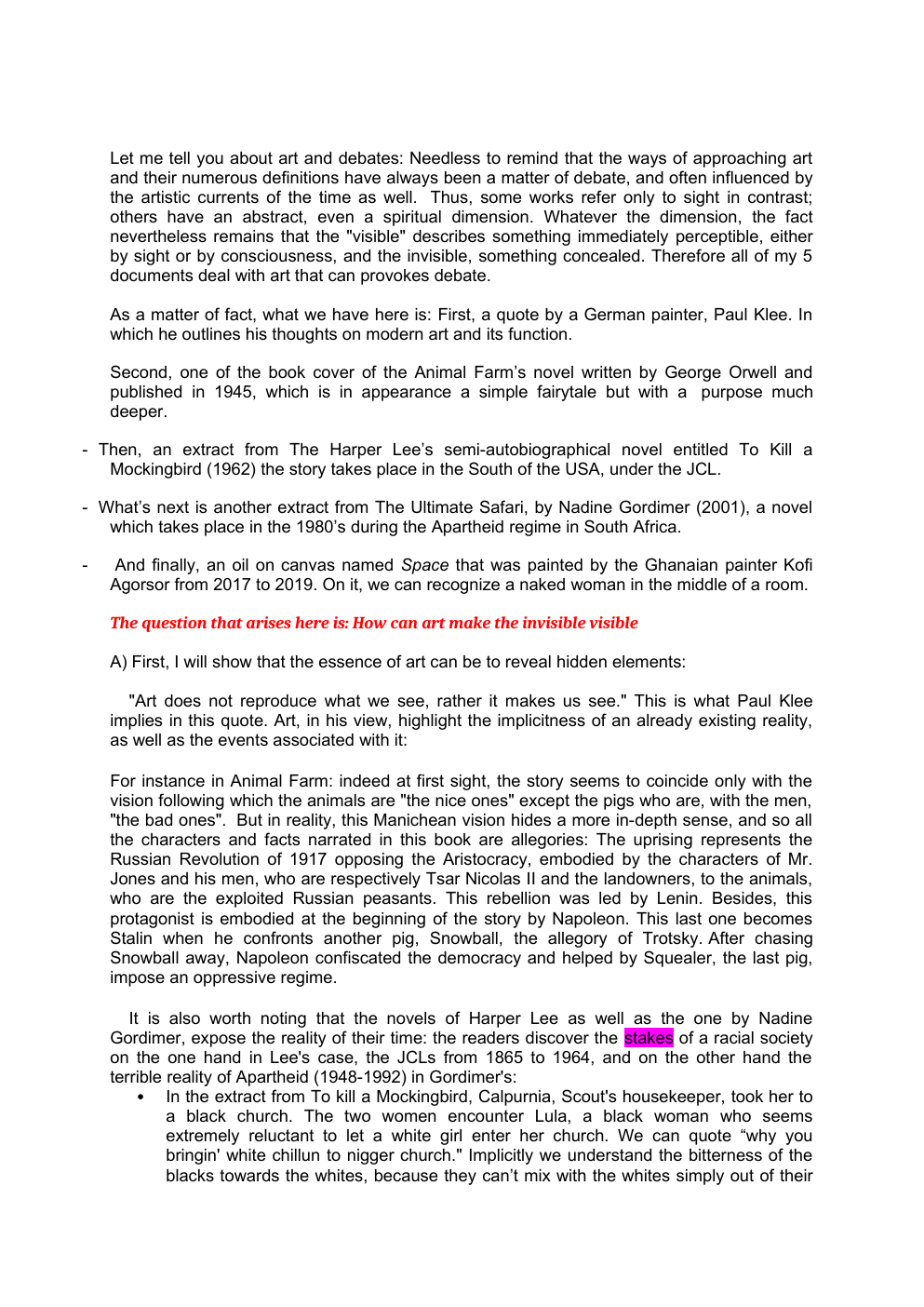oral dossier llce anglais
Publié le 10/06/2022

Extrait du document
«
Let me tell you about art and debates: Needless to remind that the ways of approaching art
and their numerous definitions have always been a matter of debate, and often influenced by
the artistic currents of the time as well.
Thus, some works refer only to sight in contrast;
others have an abstract, even a spiritual dimension.
Whatever the dimension, the fact
nevertheless remains that the "visible" describes something immediately perceptible, either
by sight or by consciousness, and the invisible, something concealed.
Therefore all of my 5
documents deal with art that can provokes debate.
As a matter of fact, what we have here is: First, a quote by a German painter, Paul Klee.
In
which he outlines his thoughts on modern art and its function.
Second, one of the book cover of the Animal Farm’s novel written by George Orwell and
published in 1945, which is in appearance a simple fairytale but with a purpose much
deeper.
- Then, an extract from The Harper Lee’s semi-autobiographical novel entitled To Kill a
Mockingbird (1962) the story takes place in the South of the USA, under the JCL.
- What’s next is another extract from The Ultimate Safari, by Nadine Gordimer (2001), a novel
which takes place in the 1980’s during the Apartheid regime in South Africa.
-
And finally, an oil on canvas named Space that was painted by the Ghanaian painter Kofi
Agorsor from 2017 to 2019.
On it, we can recognize a naked woman in the middle of a room.
The question that arises here is: How can art make the invisible visible
A) First, I will show that the essence of art can be to reveal hidden elements:
"Art does not reproduce what we see, rather it makes us see." This is what Paul Klee
implies in this quote.
Art, in his view, highlight the implicitness of an already existing reality,
as well as the events associated with it:
For instance in Animal Farm: indeed at first sight, the story seems to coincide only with the
vision following which the animals are "the nice ones" except the pigs who are, with the men,
"the bad ones".
But in reality, this Manichean vision hides a more in-depth sense, and so all
the characters and facts narrated in this book are allegories: The uprising represents the
Russian Revolution of 1917 opposing the Aristocracy, embodied by the characters of Mr.
Jones and his men, who are respectively Tsar Nicolas II and the landowners, to the animals,
who are the exploited Russian peasants.
This rebellion was led by Lenin.
Besides, this
protagonist is embodied at the beginning of the story by Napoleon.
This last one becomes
Stalin when he confronts another pig, Snowball, the allegory of Trotsky.
After chasing
Snowball away, Napoleon confiscated the democracy and helped by Squealer, the last pig,
impose an oppressive regime.
It is also worth noting that the novels of Harper Lee as well as the one by Nadine
Gordimer, expose the reality of their time: the readers discover the stakes of a racial society
on the one hand in Lee's case, the JCLs from 1865 to 1964, and on the other hand the
terrible reality of Apartheid (1948-1992) in Gordimer's:
In the extract from To kill a Mockingbird, Calpurnia, Scout's housekeeper, took her to
a black church.
The two women encounter Lula, a black woman who seems
extremely reluctant to let a white girl enter her church.
We can quote “why you
bringin' white chillun to nigger church." Implicitly we understand the bitterness of the
blacks towards the whites, because they can’t mix with the whites simply out of their.
»
↓↓↓ APERÇU DU DOCUMENT ↓↓↓
Liens utiles
- Oral LLCE Dossier Spécialité English
- Oral de LLCE Anglais - Portfolio
- Exemple d'un sujet d'oral de bac de LLCE
- oral llce
- Grand oral llce: Est-il possible de déconstruire les préjugés de notre société afin de se construire soi-même ?


